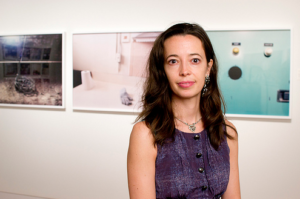Today’s post comes from Anna Rogulina, class of 2011 and Art Center student docent.

Georgia O’Keeffe’s Spring (ca. 1922) is a vividly painted canvas, bright and airy, almost effortless. When you see it for the first time, the hues of magenta, green, mauve, and blue dynamically organized into organic, interrelated forms are like an ice-cream sundae for the eyes. You look at the branch reaching upward from the lower right corner, the two pinkish spheres, possibly seeds, and the cloud-like shapes up top. All these elements make you think of beginnings, life, rejuvination. Then you notice the sharp diagonal dividing the canvas and wonder if it’s meant to be a reminder that spring can also be period of violent change, interruption, disturbance. Perhaps you continue to ruminate about the season, or the weather outside, or a childhood memory of a past spring vacation. Or maybe, you allow your eyes to simply enjoy the painting, because in the end, the mere act of looking is rewarding in and of itself. Likely, O’Keeffe would have wanted you to do all these things – to experience the joy of color and the freedom to muse about the traces of the physical world depicted in her paintings – in this case, a season. But beyond that, there is something else she would have wanted you to do.
Georgia O’Keeffe would have wanted you to understand that Spring was also a form of implicit resistance when it was first painted. When O’Keeffe entered the New York art world in the mid-1910s, she worked primarily in pure abstraction. At the time, critics tended to attach overtly sexual readings to her works by claiming them to be “expressions of a sexually liberated woman or “the world of a woman turned inside out”. Alfred Stieglitz, who exhibited O’Keeffe at Gallery 291, proposed this interpretation himself. O’Keeffe’s participation in Stieglitz’ photographic essay, titled Georgia O’Keeffe: A Portrait, which featured many close-ups of the artist’s nude body, only continued to perpetuate the overly sexualized interpretations of her paintings.
O’Keeffe was very much frustrated with the fact that critics were ascribing such one-sided readings to her abstractions. After all, for her, painting was always meant to be a liberating event. Starting in the early 20s, O’Keeffe made a conscious choice to include representational elements in her works. In doing so, she intended to clarify the origins and meanings of the abstractions she was producing. It is likely that O’Keeffe chose to render an easily identifiable branch in Spring for this very reason. Her partial return to representation was not intended to make her paintings more literal. Instead, it was an assertion that she was going to paint as she wanted to and say what she wanted to when she painted. The resulting works, such as Spring, were still very much about emotions – perhaps the kind of sensation that happens when you lean over to see a flower or breathe deeply to take in the smell of the morning dew. As O’Keeffe would write to her friend Anita, this kind of sensation was “essentially a woman’s feeling”. Eventually, for O’Keeffe, abstractions and flower paintings became significations for the liberation of all women.




